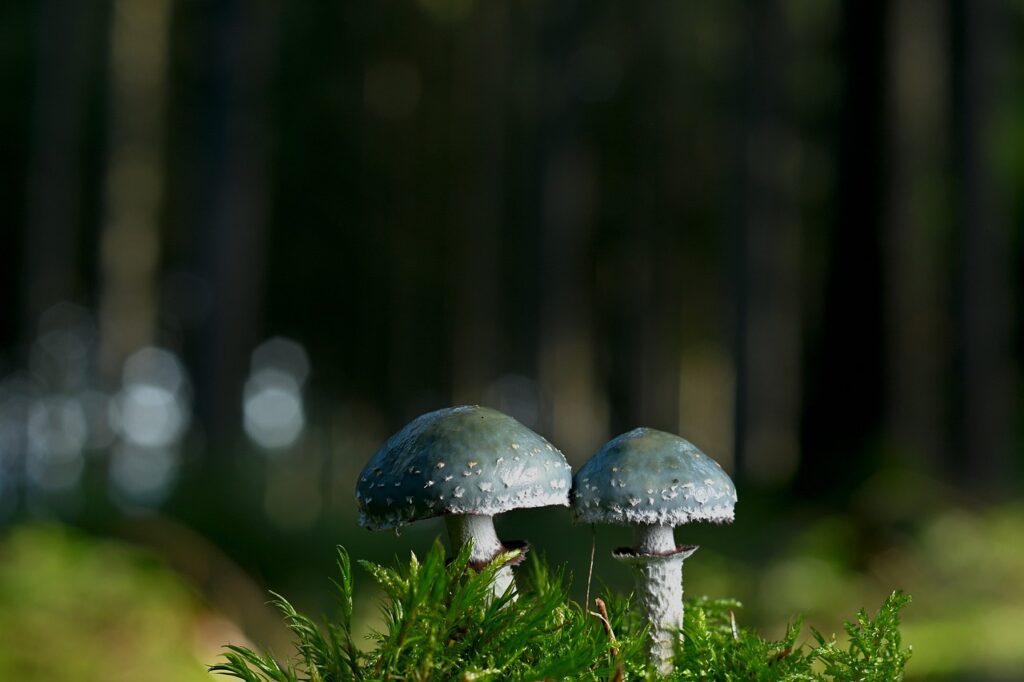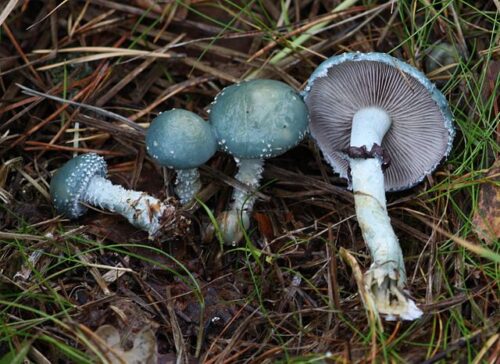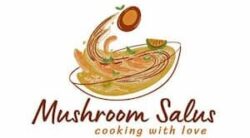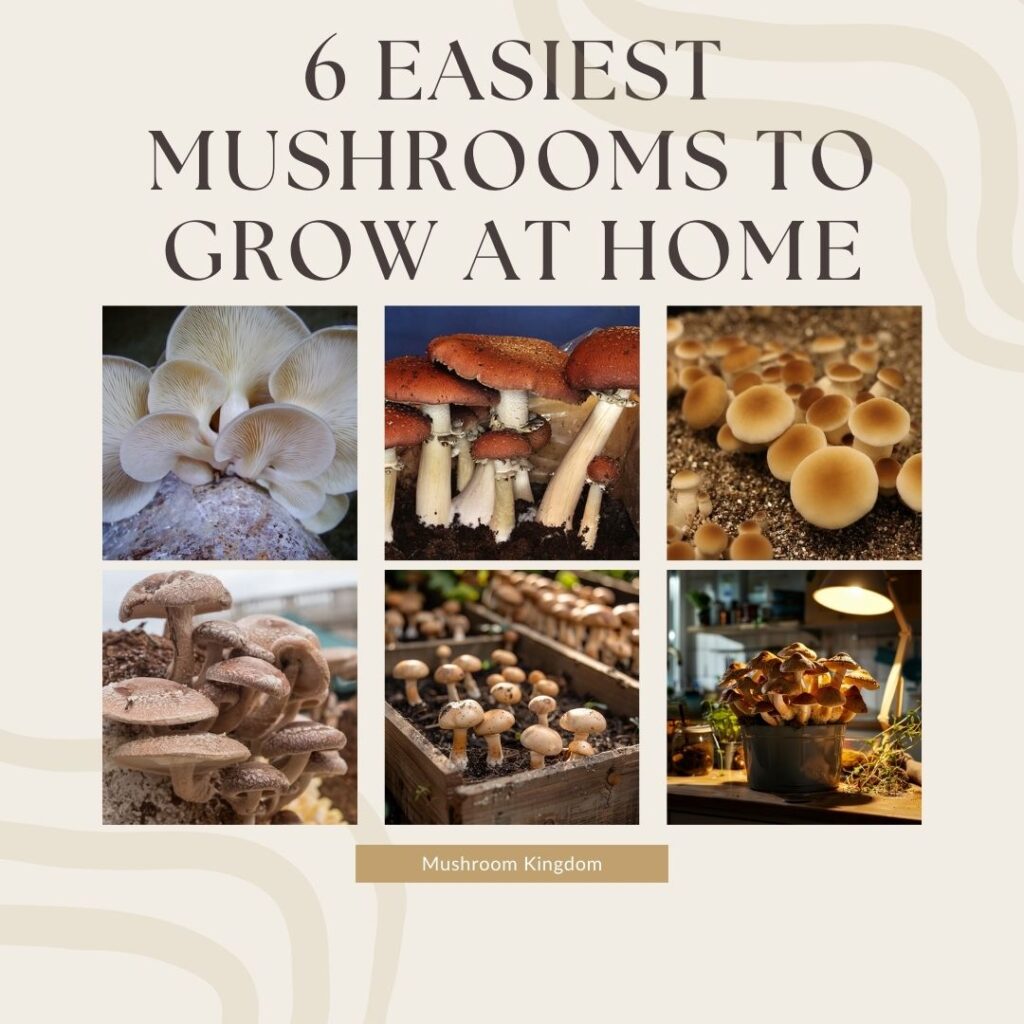Stropharia aeruginosa, commonly known as the Verdigris Agaric, is a striking blue-green mushroom often found in grassy areas and on decaying wood.
It is known for its slimy cap, purple-brown spore print, and potential toxicity, making it a species to admire but avoid consuming.
How to Identify Stropharia aeruginosa
Here’s a detailed guide to help you recognize this distinctive species.
Cap Characteristics
First, observe the cap. Stropharia aeruginosa has a cap that ranges from 3 to 10 centimeters in diameter. Initially, it is conical but becomes more convex as it matures.

The cap exhibits a striking greenish-blue hue, which can fade to a more yellowish tone with age. This is why people also called it “blue head mushroom” or “blue fungi”.
When wet, the cap is slimy or sticky to the touch, often with remnants of a universal veil in the form of white, cottony scales or patches.
This slimy texture and coloration are significant identifiers, setting it apart from many other mushrooms.
Gills Examination
Next, examine the gills. The gills of this “blue head” mushroom are adnate to adnexed. This means they are broadly attached to the stem or slightly notched before joining the stem.
Initially, the gills are pale grey but gradually turn dark purple-brown as the spores mature.

The gills are closely spaced, creating a dense appearance on the underside of the cap. This transition in color as the mushroom ages is a key feature to note.
Stem Inspection
Then, inspect the stem. The stem of this mushroom ranges from 4 to 12 centimeters in height and 0.5 to 1.5 centimeters in thickness. It is whitish with a blue-green tinge and often has remnants of the partial veil, forming a ring or zone of white, flaky material.
Below the ring, the stem surface can be scaly or fibrillose, adding a textured appearance. This scaly texture and the presence of a veil remnant are distinctive traits to look for.
Spore Print Analysis
Spore print analysis is another helpful identification step.
Stropharia aeruginosa produces a dark purple-brown spore print.
This spore color is a distinguishing feature compared to other mushrooms with different spore print colors. To obtain a spore print, place the cap gill-side down on a piece of white paper and leave it for several hours. The resulting spore print can then be examined for color and pattern.
Habitat Consideration
It typically grows in grassy areas, often on wood chips, mulch, or in compost-rich soil. It is commonly found in environments that are rich in decaying organic matter.
Additional Features
Finally, note any additional features. The mushroom has a mild, earthy smell, which is not distinctive but can be a supporting characteristic.
While not recommended for consumption due to potential toxicity, it has a mild taste when chewed and spat out.
Is Stropharia aeruginosa Edible?
While some sources claim that this mushroom is edible, there are significant reasons to be cautious.
The chemical composition of Stropharia aeruginosa can vary widely. Factors such as location, growing conditions, and mushroom maturity can influence its toxicity.
So if in doubt, leave it out.

Moreover, there is no reason to pick it up.
This specific mushroom does not have any significant culinary value. Its texture is often described as unremarkable, and its flavor is mild, bordering on bland. So even without toxic properties, it is still inedible for most people.
With so many other mushrooms offering superior taste and texture, the potential benefits of consuming are minimal compared to the risks.
Stropharia aeruginosa Look-Alikes
Identifying Stropharia aeruginosa can be challenging due to its similarity to several other mushroom species. Here are some notable look-alikes and tips on how to distinguish them from Stropharia aeruginosa.
Stropharia caerulea
Firstly, Stropharia caerulea, also known as the Blue Roundhead, closely resembles Stropharia aeruginosa. Both mushrooms share a blue-green hue and similar size. However, Stropharia caerulea tends to have a more uniform blue color and lacks the slimy, sticky cap surface that characterizes Stropharia aeruginosa. Additionally, Stropharia caerulea’s cap often appears more matte and less shiny.
Cortinarius species
Several species within the Cortinarius genus also resemble verdigris agaric.
For instance, some Cortinarius species display blue or greenish caps. Yet, a key distinguishing feature of Cortinarius mushrooms is the presence of a cortina — a web-like veil that covers the gills in young specimens and often leaves a rusty-brown spore deposit on the stem. In contrast, Stropharia aeruginosa lacks this cortina and produces a dark purple-brown spore print instead.
Psilocybe cyanescens
Another look-alike is Psilocybe cyanescens, commonly known as the Wavy Cap. This species can also exhibit a bluish tint, particularly when bruised.
However, Psilocybe cyanescens has a distinct wavy edge to its cap and typically grows in clusters on wood chips and mulch. It also contains psychoactive properties, containing psilocybin and psilocin, which Stropharia aeruginosa lacks.
Leratiomyces ceres
Leratiomyces ceres, also known as the Redlead Roundhead, might be mistaken for a weathered Stropharia aeruginosa when its cap color fades. Although Leratiomyces ceres usually has a reddish-orange cap, older specimens can take on a more yellowish-brown hue.
However, Leratiomyces ceres generally retains a more pronounced orange tint around the edges.
Hypholoma species
Hypholoma species, particularly Hypholoma fasciculare (the Sulphur Tuft), can sometimes be confused with Stropharia aeruginosa, especially in dim lighting where color distinctions are less apparent.
Hypholoma fasciculare typically has a bright yellow cap with greenish tinges and grows in dense clusters on decaying wood.
Deconica species
Lastly, Deconica species, such as Deconica coprophila, may also resemble Stropharia aeruginosa in shape and size. These mushrooms usually have a more brownish or reddish-brown cap and grow on dung or in heavily fertilized soils. Deconica species do not have the blue-green coloration of Stropharia aeruginosa and lack the slimy cap surface.
Little-Known Facts About Stropharia Aeruginosa
One of the most striking features of Stropharia aeruginosa is its vibrant blue-green color.
This distinctive hue is due to the presence of unique pigments that are rare among mushrooms. The color can fade to a more yellowish tone as the mushroom ages, but the initial blue-green shade is unmistakable and eye-catching.
Sticky Cap Surface
The is slimy or sticky when wet. This characteristic, known as being viscid, helps the mushroom retain moisture and may also play a role in protecting it from pests and environmental factors. The slimy surface can often have remnants of a universal veil, giving the cap a speckled or patchy appearance.
Bioluminescence
Under certain conditions, parts of the mushroom may glow slightly in the dark. While not as pronounced as some other bioluminescent fungi, this glow adds to the mushroom’s mystique.
Chemical Defense Mechanisms
The mushroom produces several secondary metabolites that serve as chemical defenses against predators and pathogens.
These compounds can deter insects, grazing animals, and microbial competitors. The exact nature and effects of these metabolites are still being studied, but they contribute to the mushroom’s resilience in its natural habitat.


